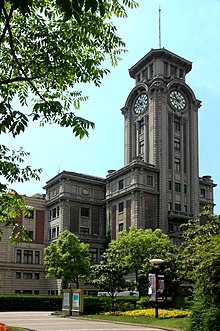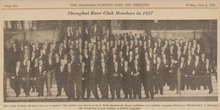Shanghai Race Club
The 1934 building has been described thus: The grandstand was thought at the time to be the largest in the world, and probably was, while the Race Club, with its marble staircases, teak-panelled rooms, oak parquet floors, and its coffee room which was 100ft by 47ft[a] with a huge fireplace, most certainly ranked as the most sumptuous club of its kind yet built in any country.
The influx of refugees fleeing the Taiping Revolution rebels caused a sharp rise in city centre property prices in Shanghai.
The land enclosed by the race track was sold to the Recreation Club for use as sports grounds.
The Race Club prospered from the influx of migrants into Shanghai in the early 20th century and the sale of hugely popular raffle tickets from 1908.
By 1938, it had purchased all of the assets of its former parent, the Shanghai Recreation Club (which had lost its major source of revenue when the Kiang-wan Racecourse was ransacked by invading Japanese troops), including the sport field surrounded by the racecourse.
However, due to public outcry about this vestige of colonialism in central Shanghai and the reputation of the racecourse as a gambling den, the government did not permit race meetings to be resumed.
From 1946, the Republic of China government began negotiations with the Race Club to resume the racecourse.
[2] After the Communist takeover of Shanghai in 1949, the Trustees of the Shanghai Recreation Fund wrote to the new Communist administration to voluntarily hand over the properties of the Recreation Club, including the sports ground at the centre of the Racecourse.
As the Club still could not organise races, it did not have any significant income, and by 1954 owed large amounts of land tax and staff salary.
[5] At first, membership of the Race Club was restricted to foreign (non-Chinese) residents over the age of 21.
After 1909, the sale of raffle tickets were introduced, and quickly outstripped betting on horses as the primary source of revenue for the Shanghai Race Club.
Horse racing-themed raffle tickets issued by the Race Club were sold across China.
Purely a game of chance and not requiring any knowledge of racing, the raffles were very accessible and proved extremely popular with Chinese residents, and also attracted criticism of the Race Club from social commentators for running essentially a pure gambling scheme.
The November 12, 1941 Champions Day was the last one under the direction of the British directors of the Shanghai Race Club, just three weeks before the Japanese army occupied the International Settlement.
[6] The original Shanghai Race Club Limited, registered in Hong Kong, was dissolved in 2009.
The business operates in mainland China, and concentrates on showcasing European horse racing as a prestige lifestyle.








